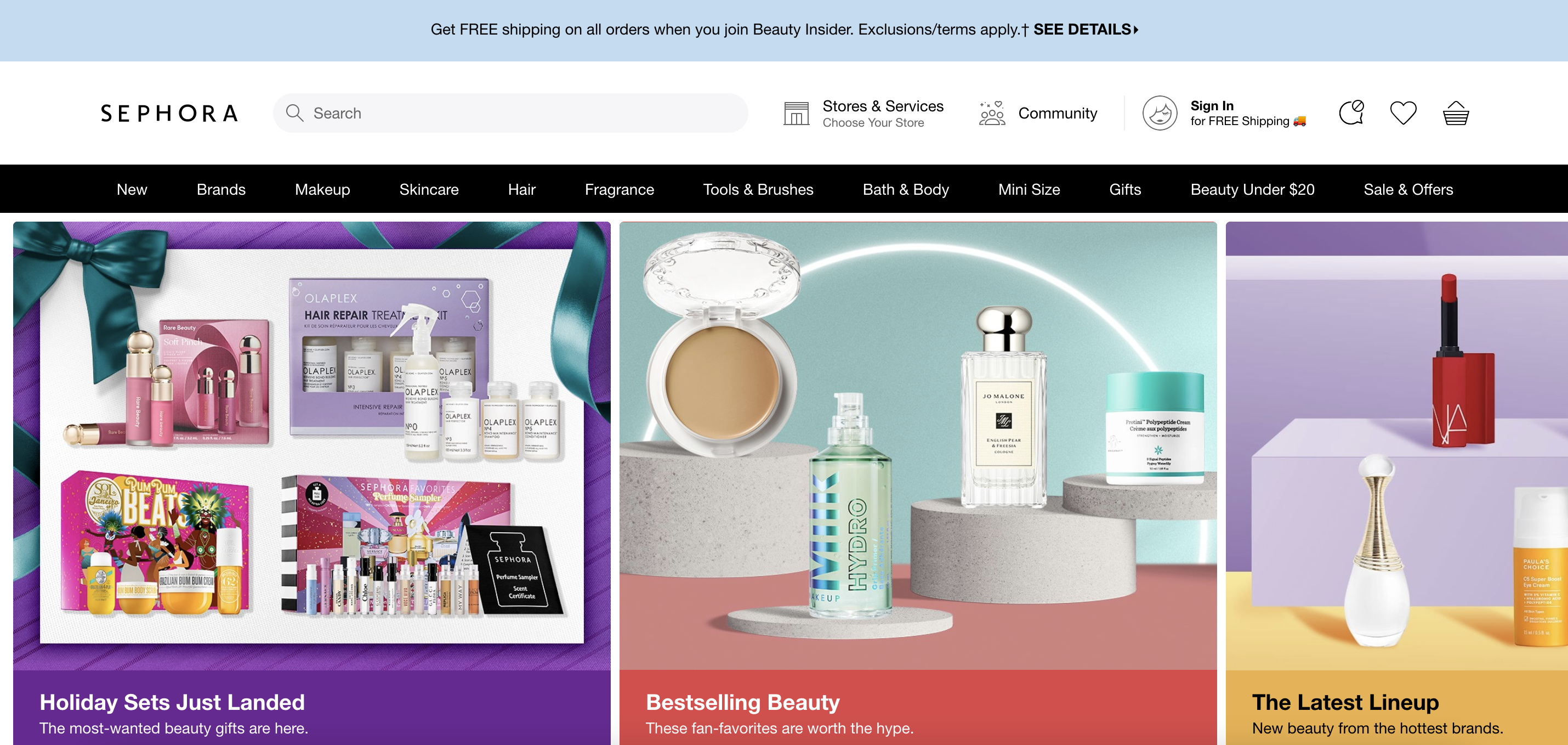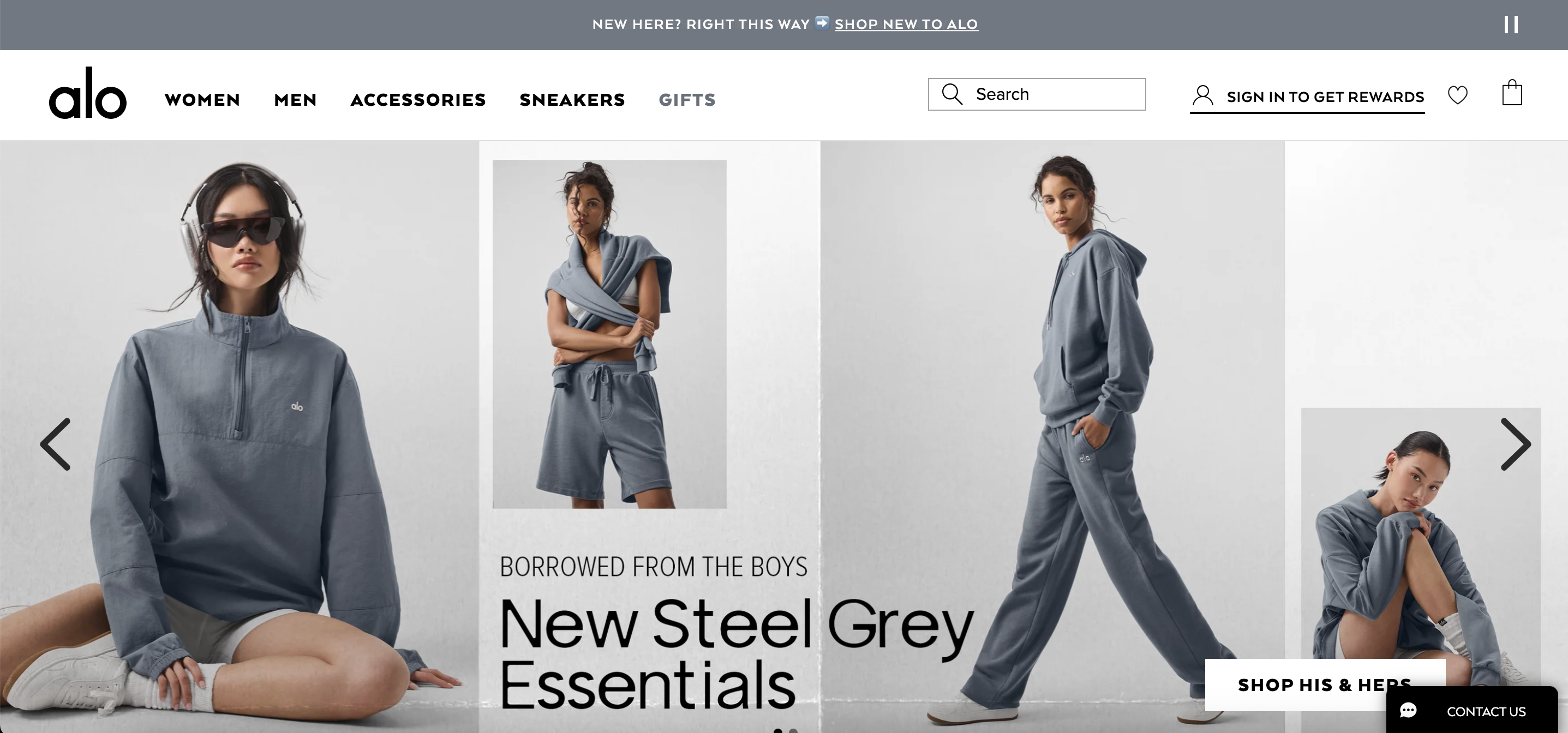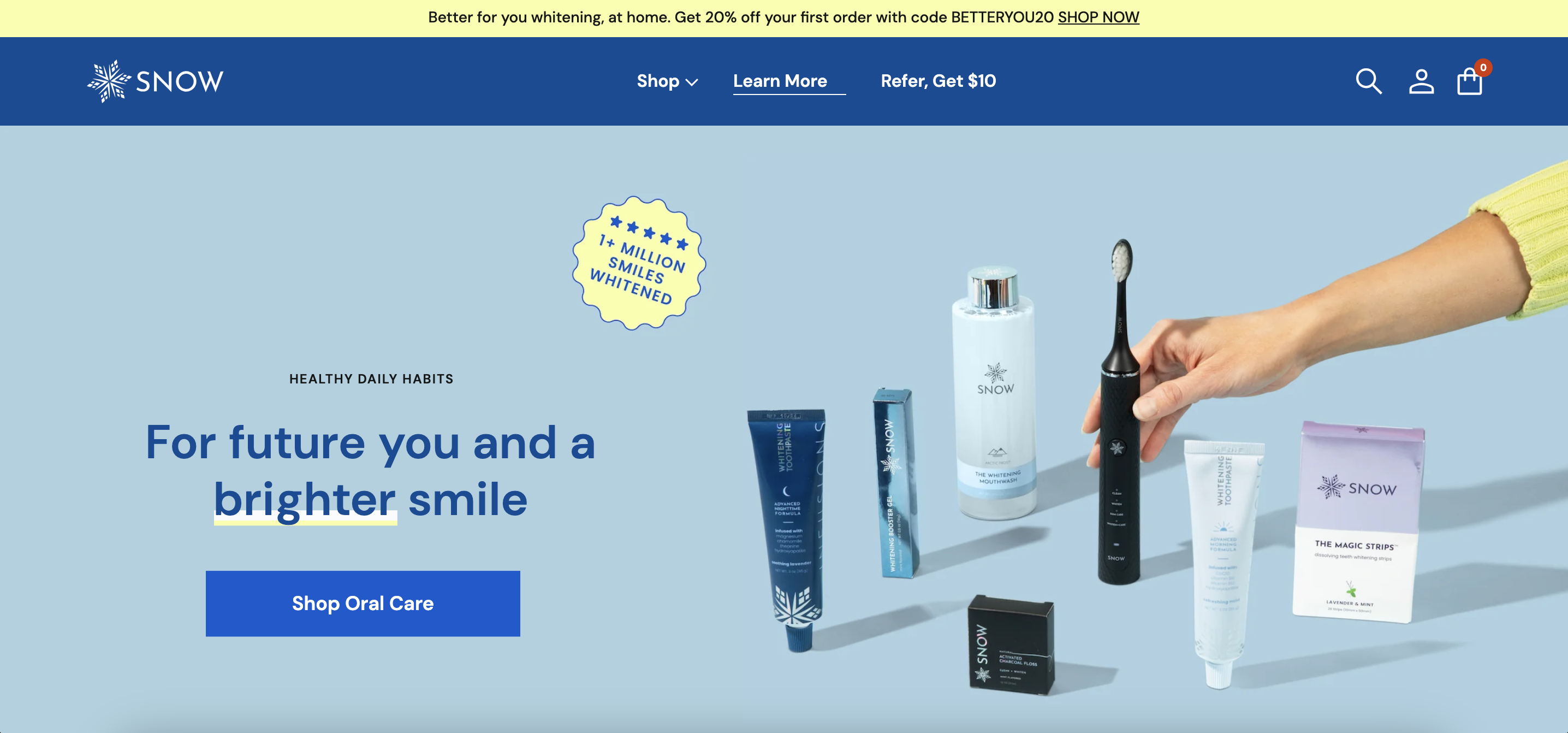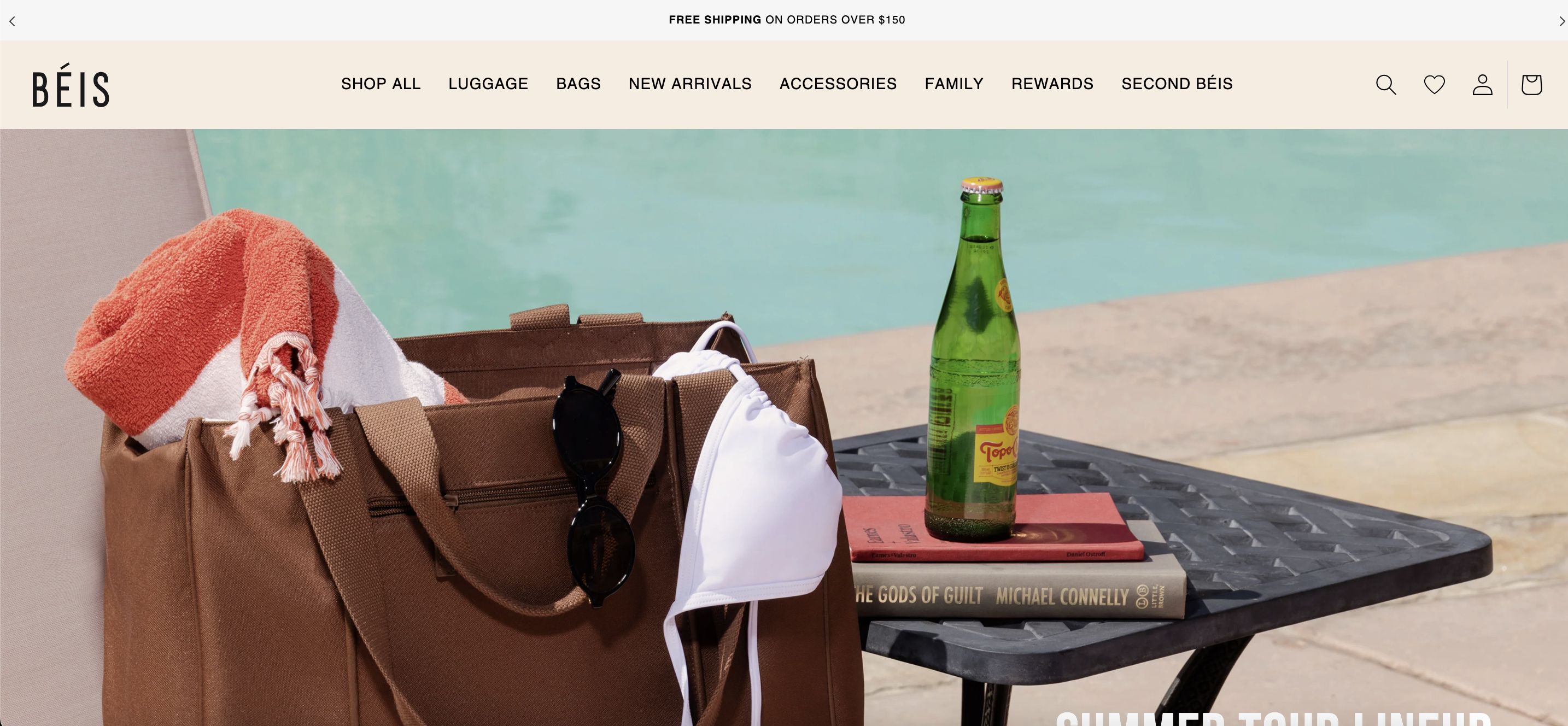- Blog
- 20 Ecommerce Case Studies to Inspire You
20 Ecommerce Case Studies to Inspire You
-
Nikolett Lorincz
- Ecommerce
- 6 min read
Table of Contents
We’ve spent hundreds of hours analyzing the world’s most successful DTC companies and ecommerce brands, including Sephora, Dollar Shave Club, Casper, Warby Parker, and Allbirds, to create ecommerce case studies you can use as inspiration for your own online store.
Today, we’ll share with you the 20 best ecommerce case studies that you can use to help drive more visitors to your website and convert more customers.
Let’s get right into it!
1. The Farmer’s Dog marketing strategy: 6 tactics that you can apply in your own business

The Farmer’s Dog was founded in 2014 by two dog lovers. 6 years later, they’re delivering millions of meals monthly.
How did they do it?
We analyzed their sales funnel and boiled it down to 6 lessons you can apply in your own business to generate more sales.
2. The secret behind the Care/of marketing strategy

Every small ecommerce site owner dreams about a success story like Care/of’s. They achieved a $225 million valuation and were acquired by Bayer in just 6 years.
In this case study, we analyze the marketing strategies that Care/of used, including:
- Quiz funnel
- Content marketing
- Social media
- Paid advertising
- Messaging
Get inspired by these strategies to grow your own online sales.
3. Dollar Shave Club marketing success

Dollar Shave Club is one of the most talked-about DTC brands, and with good reason. Their famous “our blades are f***ing great” video went viral in just a few days. The video went on to collect 4.75 million views in the first 3 months and has over 27 million views today.
This launch video gave them a killer head start, and their witty brand voice, strong content marketing campaigns, and direct-to-consumer business model enabled them to grow further. They were so successful that Unilever bought the company in a billion-dollar cash acquisition in 2016.
In this case study, we cover everything you need to know about Dollar Shave Club’s marketing game plan to build your own billion-dollar empire.
4. How Casper took the mattress industry by storm and reached a $1.1 billion valuation

In this case study, you’ll get a sneak peek into how Casper was able to build unprecedented trust and convince people to purchase mattresses online.
We look at their well-rounded content marketing strategy, which covers topics of interest for visitors at every stage of the buyer’s journey.
We also discuss how they utilize social proof to build trust, their unbeatable guarantee, and their referral marketing strategies. Don’t miss this one!
5. How Glossier became a $1.2 billion company

Glossier is one of our favorite ecommerce case studies. If you have a beauty brand, you’ll want to read it.
We’ve studied Glossier’s entire customer experience to find 5 lessons you can use for your own brand:
- Know your target audience and build relationships with them
- Use (micro-) influencer marketing
- Focus on branding
- Publish engaging content
- Provide an amazing user experience
Click the link below for all the juicy details.
6. How Happy Box 10x-ed their online store revenue during Covid

Happy Box is not as well-known as some of the other ecommerce stores on this list, but its growth is bound to inspire you.
The company started as a side project and grew into a full-time ecommerce business during the Covid pandemic. In fact, they were able to achieve a 10x growth rate in 2021!
In this case study, we look at the marketing blueprint behind their astounding success.
7. How Warby Parker reached a $3 billion valuation and became an ecommerce giant

The idea of buying eyeglasses online was uncharted territory for consumers a decade ago. But Warby Parker’s phenomenal marketing helped to overcome that challenge.
Their website crashed just after its official launch, their top 15 most popular styles sold out within 4 weeks, and they collected a waitlist of 20,000 customers during that time.
In this post, we share the key strategy Warby Parker used to reach its target audience so quickly and went on to become the $3-billion giant everyone knows.
8. 4 steps for growing your brand organically using ColourPop’s marketing strategy

In this case study, we share 4 key takeaways from ColourPop’s winning social media strategy:
- Give freebies in exchange for authentic reviews
- Build meaningful relationships with your influencers
- Get your hashtag trending
- Host Instagram giveaways
Check out the tips that you can easily copy for your own ecommerce company.
9. Replicate Urban Outfitters’ marketing strategy with these 4 tips

Urban Outfitters is different from a lot of the ecommerce brands on this list because they didn’t start online and grow into a global retail giant… instead, they started as a brick-and-mortar business (back in 1970) and managed to make the successful transition to online sales.
It’s worth talking about them because they’re fantastic at keeping in touch with their target audience (Millennials and Gen Z). They also succeed in strengthening customer loyalty with a rewards program.
Check out this case study to learn how you can do the same with your business to drive sales.
10. How Gymshark bulked up into a $1 billion+ brand

Gymshark is well known for its influencer marketing strategy. In fact, the company was one of the early adopters of influencer marketing.
In this case study, we cover how Gymshark managed to build its fan base, and we spill the beans on what they’re still doing today to delight customers. Check out our 6 key takeaways below!
11. How Allbirds went from a small startup to a billion-dollar sneaker brand in 4 years

Allbirds is among the most popular ecommerce businesses, especially among circles of professionals in Silicon Valley, including Google co-founder Larry Page. The company differentiates itself from competitors by focusing on three important principles:
- Comfort
- Simple design
- Sustainable shoes, made from nature
Check out this case study to learn how they fight with their competitors, how they use PR campaigns and word-of-mouth marketing to get people talking about the brand, and more.
12. How Lunya achieved $25M revenue

Lunya was able to disrupt the women’s sleepwear industry quickly by creating products that bridge the gap between style and sensibility. According to Lunya co-founder Ashley Merrill, the brand was able to grow by putting customers first and never losing sight of the customer’s perspective.
We analyzed the steps Lunya took to build their brand and create a successful customer-centric strategy.
13. 6+1 tips from Rituals to create meaningful moments online

Rituals, founded in 2000, has an impressive product line including skincare, body care, makeup, and scented candles.
They really care about their customers and focus on creating an engaging customer experience online. We wanted to find out how they do it, so in this case study, we explore 6+1 tips from the marketing masters at Rituals.
14. 13 solid tips for mastering the art of personalization like Sephora

Sephora is a cosmetic behemoth that we can all learn from. What’s the secret behind their worldwide success?
In this case study, we share 13 tips they use to delight customers and create loyalty, including:
- Driving sales through personalization
- Helping customers make informed purchasing decisions
- Using YouTube to drive conversions
- Nurturing long-term customer relationships
- and more!
15. How Alo Yoga scaled to $247M in revenue

Alo Yoga is an athleisure brand known for its “studio-to-street” clothing, making it perfect for both yoga sessions and everyday wear. Founded in 2007 in Los Angeles, Alo Yoga has grown steadily, now boasting an annual revenue of $247.1M and 3 million Instagram followers.
In this ecommerce case study, we’ll share the key marketing strategies that have fueled Alo Yoga’s success.
You can discover their community-building tactics, how they leveraged user-generated content, created personalized experiences for visitors, and more.
16. Bloom & Wild’s marketing strategy to become the 2nd fastest-growing startup

Bloom & Wild, an online florist operating in the UK, Austria, France, Germany, and Ireland, has become one of the fastest-growing online stores in its category. In 2021, the company raised $102 million in investment capital.
Bloom & Wild achieved this impressive business growth by focusing on:
- Caring about their customers
- Increasing on brand awareness with TV campaigns and dominating search results
- Customizing content for each social media channel
- Encouraging referrals
- Building loyalty with a subscription model
17. How SNOW® Teeth Whitening achieved $100M in online sales

SNOW® Teeth Whitening is a DTC oral care brand focused on delivering professional-level whitening with an at-home kit.
Founded by Josh Elizetxe (a.k.a. Josh Snow) in 2017, SNOW® has quickly gained millions of fans. Over 13 million people shopped SNOW® products in 2021 alone, and by 2020, the company hit $100 million in sales after just three years online.
So, how did SNOW® achieve such significant growth?
In this ecommerce case study, you’ll learn how:
- They focus on creating and continually improving a product that meets customer needs.
- Each ad SNOW® puts out highlights the pain points that their product solves.
- They diversify channels.
- They leverage owned media for customer engagement.
- They collaborate with A-list celebrities to build brand awareness and credibility.
18. Athletic Brewing Co.: A masterclass in community-first marketing

Athletic Brewing Co. didn’t just create non-alcoholic beer—they built a movement around it. By focusing on health-conscious, active consumers, they tapped into a new niche and built an authentic brand.
In this case study, we break down how Athletic Brewing:
- Created a lifestyle brand around mindful drinking
- Leveraged storytelling and mission-driven marketing
- Used content and community engagement to grow organically
- Partnered with athletes and outdoor events to expand reach
If you’re looking to build a passionate customer base, don’t miss this one.
19. How a weighted blanket brand won the hearts of wellness lovers

Bearaby proves that even a niche product like weighted blankets can become a cult favorite—if you get the branding right.
We take a closer look at Bearaby’s growth strategy, including:
- Their premium product positioning and focus on sustainability
- A visually stunning, scroll-stopping website
- How they combine education and aesthetics on their PDPs
- Smart use of press, SEO, and organic growth
It’s a perfect case study for DTC brands focused on wellness and aesthetics.
20. How BÉIS Travel went from influencer brand to luggage empire

Founded by actress Shay Mitchell, BÉIS built a brand rooted in functionality, sleek design, and customer insights.
This case study explores how BÉIS:
- Used feedback to inform product development
- Built viral social campaigns that drove massive engagement
- Crafted a clear, consistent brand aesthetic
- Leveraged UGC and travel-focused content to build community
If you’re working in fashion or lifestyle ecommerce, this one’s a must-read.
Final thoughts
Well, that’s it—these are the best ecommerce case studies we’ve found during our extensive research! Hopefully you’ve found plenty of inspiration on this list.
No matter how big (or small) your company is or what industry you’re in, you can use tips and strategies from these ecommerce case studies in your own store.
Which ecommerce case study is your favorite?
Migration has never been easier
We made switching a no-brainer with our free, white-glove onboarding service so you can get started in the blink of an eye.

What should you do next?
Thanks for reading till the end. Here are 4 ways we can help you grow your business:
Boost conversions with proven use cases
Explore our Use Case Library, filled with actionable personalization examples and step-by-step guides to unlock your website's full potential. Check out Use Case Library
Create a free OptiMonk account
Create a free OptiMonk account and easily get started with popups and conversion rate optimization. Get OptiMonk free
Get advice from a CRO expert
Schedule a personalized discovery call with one of our experts to explore how OptiMonk can help you grow your business. Book a demo
Join our weekly newsletter
Real CRO insights & marketing tips. No fluff. Straight to your inbox. Subscribe now
Nikolett Lorincz
- Posted in
- Ecommerce
Partner with us
- © OptiMonk. All rights reserved!
- Terms of Use
- Privacy Policy
- Cookie Policy
Product updates: January Release 2025








